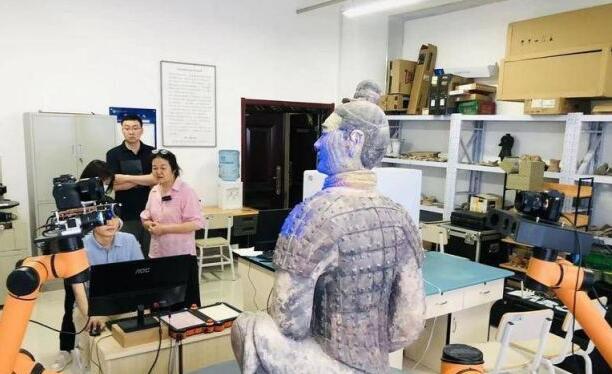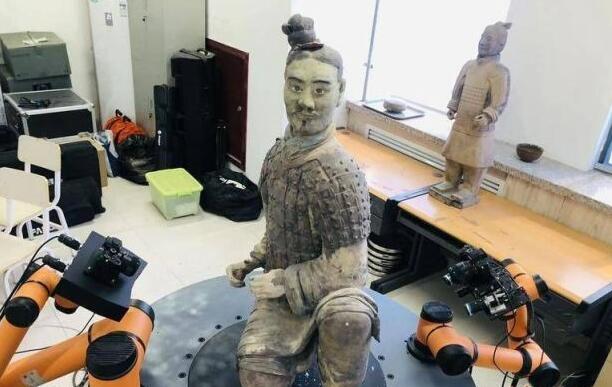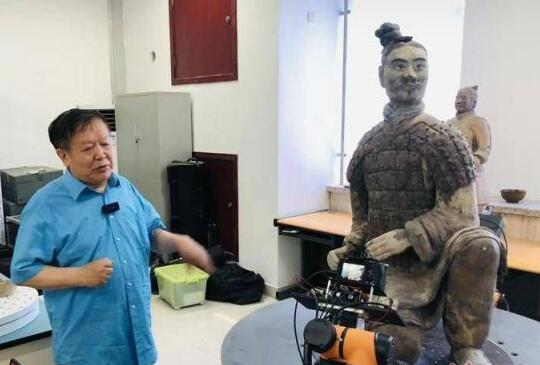At Northwestern University in the ancient capital of Xi’an, robots are replacing manual hand-held scanners to paint and preserve precious cultural relics.
The scientific name of this robot is a rapid collection and modeling device for the appearance of cultural relics. It was developed by Chinese scientists using machine vision, robotic arms and other technologies for one year. The developer is Xu Yang, a teacher from Northwest University. He graduated from the School of Instrument Optoelectronics of Beihang University with a doctorate degree and has been engaged in the research of visual measurement technology for rockets and aircraft. He introduced the robotic arm technology commonly used in aerospace manufacturing into heritage conservation work.
“The main role of the robotic arm is to replace manual data collection. The length of the robotic arm we use reaches 1.5 meters, which enables the digital collection of cultural relics to have the significant advantages of automation and less manual intervention.” Xu Yang said.
He introduced that the robot’s “eyes” consist of a structured light 3D scanner and a high-resolution color camera, called the cultural relic appearance data acquisition module. Its mechanical arm is similar to the body, and the large-diameter rotating platform is like two feet. During the collection process, the robotic arms carrying the data collection module for the appearance of cultural relics are arranged on both sides of the rotating platform. By rotating 180 degrees around the cultural relics, the complete collection of the appearance data of the cultural relics is realized.

“Project structured light on the surface of the cultural relic through the fringe projector, and decode the structured light with the help of the structured light images captured by two industrial cameras. With the movement of the robotic arm and the rotation of the turntable, the three-dimensional topography of the surface of the cultural relic is finally completed. Complete collection.” Xu Yang said.
Compared with manual hand-held scanning, the robotic acquisition method avoids interference or even damage to cultural relics. “During the collection process, the cultural relics are placed in the non-rotating area in the center of the rotating platform and remain stationary at all times. The collection module carried by the robotic arm shoots in space, minimizing the interference and damage to the cultural relics.”

This digital acquisition method significantly improves the acquisition efficiency. “Take a terracotta warrior as an example, it may take half a day to measure and take pictures manually.” Xu Yang said, “Using the cultural relics appearance we developed to quickly collect the modeling device, press an automatic scan button, it takes about 5 minutes. It can automatically complete the entire scanning step, and then press an automatic processing button to calculate the three-dimensional data on the surface of the cultural relic. The whole process takes less than 10 minutes, and the automatic collection and synthesis of the shape and texture data of the cultural relic is realized.”
In addition, the improved measurement accuracy is also a significant advantage of this technology. “Our sampling density is very high, and the minimum point distance of the point cloud can reach 0.1 mm. The acquisition resolution of texture information will be higher, which can be 0.05 mm. Finally, a 3D model of cultural relics with texture images is generated. In a virtual environment, we can perform virtual repairs on it.” Xu Yang said.
At present, this digital collection method will gradually be put into use in institutions such as the National Museum of China. “This will significantly improve the efficiency of the digitization of cultural relics in our collection. We plan to develop different series, such as different collection equipment for small-sized or large-sized cultural relics, to achieve more efficient collection.” Xu Yang said.




GIPHY App Key not set. Please check settings